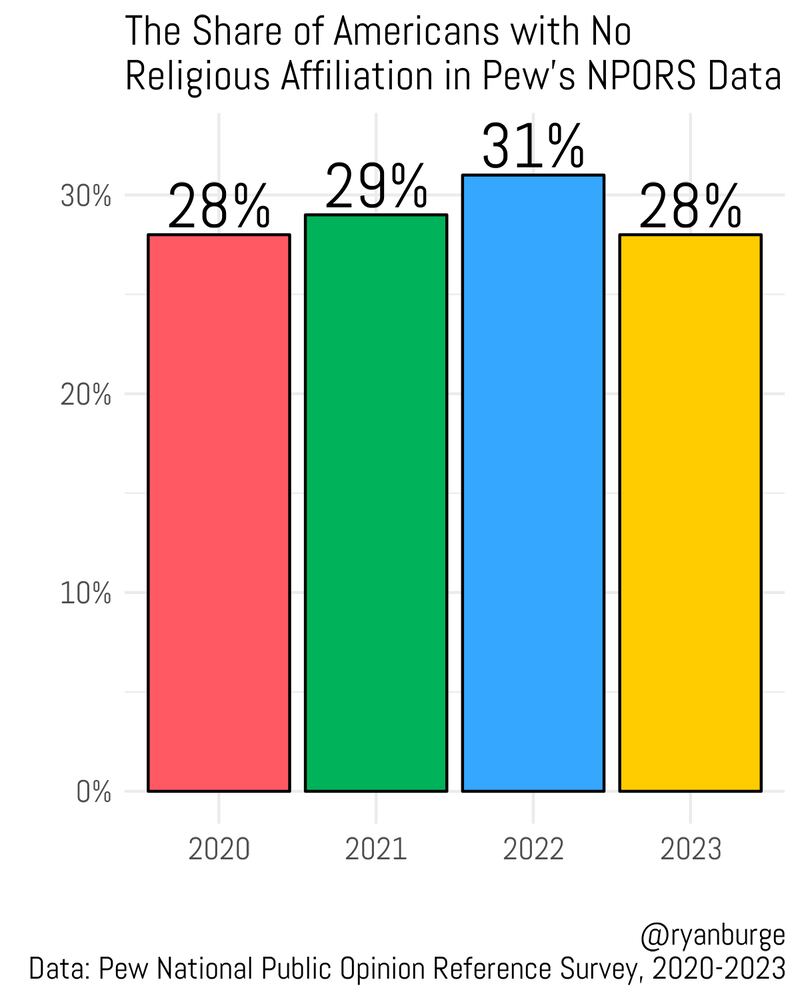It’s hard to believe that when I was born in 1974, the percentage of the U.S. population who did not identify as religious was around 5%. Now, when I am about to turn 50 years old, that number is over 30% (Pew Research Center) — representing at least a six-fold increase over my lifetime.
This trend has been referred to as the “rise of the nones” (with nones representing the combined percentage for atheists, agnostics and people who select “nothing in particular” when asked about their religion). This eye-popping demographic shift has been fodder for much discussion among social scientists, religious leaders, journalists and commentators.
Until recently, the rise of the nones didn’t appear to have any end in sight. In the graph below, see various projections the Pew Research Center made about the future path of the nones as a percentage of the U.S. population. As you can see, they predicted a continual rise of up to 52% by 2070.
 Opens in new window
Opens in new windowYet to many people’s surprise, sociologist Ryan Burge recently released statistics based on Harvard’s Cooperative Election Study claiming that the rise of the nones has already plateaued. In the following graph, you can see that the percentages of the U.S. population who are atheist (6%), agnostic (6%) and nothing in particular (23-24%) remained stable from 2021 to 2023, totaling around 36%.

While it may be interesting to see statistical evidence from one source, it’s understandably easy to write that off as a potential anomaly. But when data trends can be verified from independent data sources, it’s time to pay attention. Thus, in addition to the Cooperative Election Study, Burge also provided these next two graphs based on data from the General Social Survey and Pew Research Center.


In both graphs, you can see a dip at the most recent wave of data. In other words, three legitimate surveys conducted by three different organizations all triangulate on a potential plateauing of the rise of the nones.
Seeing this trend in three national datasets led Burge to proclaim in his post, “The rise of the nones may be largely over now. At least it won’t be increasing in the same way that it did in the prior thirty years.”
Later, he adds, “This really may be the end of an era in American religious demography. The trend lines might have reached an inflection point, and we can demarcate religious history around this time period.”
This may be jumping the gun a bit, since only time will tell if this is just a temporary blip. But if it really is flattening, then why did the plateauing of the rise of the nones happen earlier than anticipated? Burge speculates a bit on that point, stating, “I think the easiest explanation is that a lot of marginally attached people switched to ‘no religion’ on surveys over the last decade or two. Eventually, there weren’t that many marginally attached folks anymore. All you had left were the very committed religious people who likely won’t become nones for any reason. The loose topsoil has been scooped off and hauled away, leaving nothing but hard bedrock underneath.”
There are real limits to our understanding of why this is happening, with historical trends being notoriously challenging to unpack because of so many moving parts. For example, the rise of the nones started in the early 1990s, and corresponded to the rise of the internet, the rise of the “Religious Right,” and the end of the Cold War. Likewise, the plateauing of the nones may be linked to the aging of millennials and Generation Z, the waning of the New Atheist movement and the COVID-19 pandemic.
Let’s assume the rise of the nones is over, or has at least slowed, for now. Where does that leave us as a nation? Well, about like the average European country. A recent report by FBK-ISR has the average percentage of nones across European countries at just over 30%. Yet even so, Americans who say they are religious still tend to be more religious than their European peers, at least for now.
What are the implications of the plateauing of the nones for our nation moving forward? Well, it means the U.S. will remain a predominantly religious country. In other words, at least in the sense of religious affiliation rates, secularization may be leveling off.
Nevertheless, although the majority of Americans (two-thirds) still identify as religious, being religious is no longer a given for being American. Thus, increased focus might be placed on shared values that can unite us (those of various faiths and those who are not religious), such as compassion, fairness and autonomy. Religious organizations could also underscore common values and goals, such as worshipping God and serving others. Such efforts to come together are needed now as much as ever.
Sam Hardy is a professor of psychology at Brigham Young University. He is a developmental psychologist whose research focuses on religious development across adolescence and adulthood.


